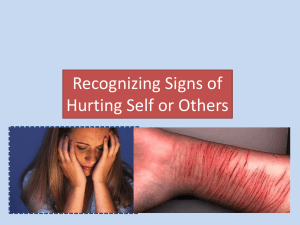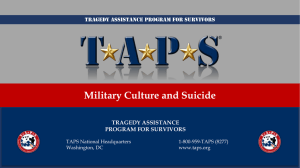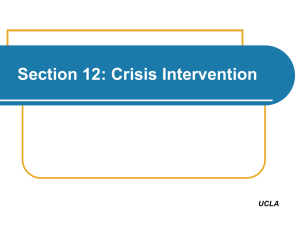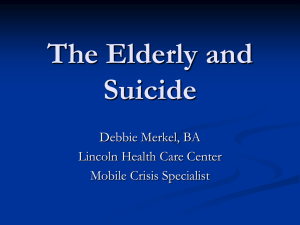Assessing the Complex Needs of Older Adults
advertisement
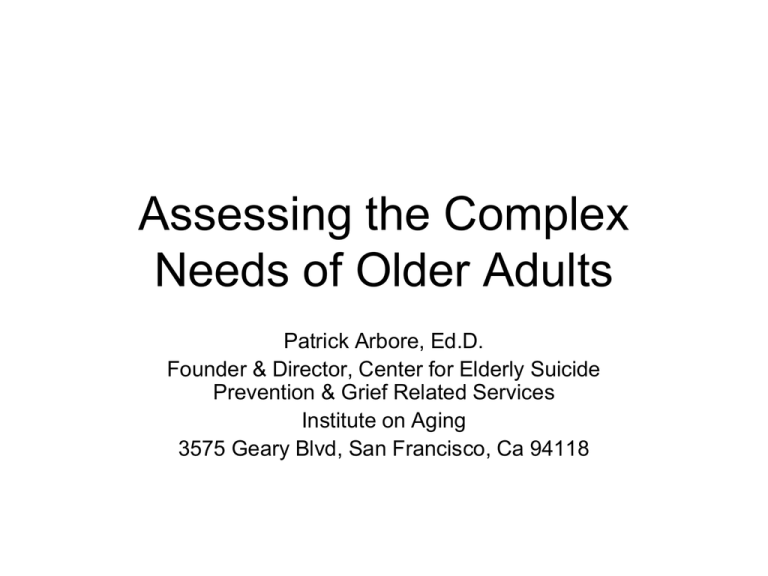
Assessing the Complex Needs of Older Adults Patrick Arbore, Ed.D. Founder & Director, Center for Elderly Suicide Prevention & Grief Related Services Institute on Aging 3575 Geary Blvd, San Francisco, Ca 94118 Center for Elderly Suicide Prevention & Grief Related Services (CESP) 24-hour Friendship Line for the Elderly – (800) 971-0016 Grief Related Services – Individual Grief Counseling and Traumatic Loss Grief Groups Medication Oversight Project Contact: parbore@ioaging.org or (415) 7504180x230 Approach to the Elderly is Different • • • • • • Spectrum of complaints is different Manifestations of distress subtle Presentations frequently nonspecific Symptoms difficult to interpret Potential for functional loss Improvements sometimes less dramatic and slower to appear • Advanced directives imperative What is Comprehensive Geriatric Assessment (CGA)? • In-depth evaluations in multiple domains • Interdisciplinary approach • Addresses the multiple medical problems of the elderly • Catalogues the resources and strengths of the older person • Assessment of need for services • May include development of team-coordinated care plan • Allows for tailored, focused interventions for each specific older person What is CGA? • Requires not only physical data but also an integration of the biologic, psychosocial, and functional aspects of the older person • Inquiries into physiologic, and anatomic function, growth and development, family relationships, group involvement, and religious and occupational pursuits are essential CGA and Care Regimens • Primary Care – aimed at prevention of disease and promotion and maintenance of health • Secondary Care – involves specific illness or pathologic conditions and focuses its efforts on the retardation or termination of physical, mental, social or environmental situations that have induced the conditions Care Regimens Continued • Tertiary Care – deals with restorative measures that will enable the older person to achieve an optimum level of function, whatever that might be Assessment Requirements • Requires special abilities of the professional – ability to listen patiently; to allow for pauses; to ask questions that are not often asked; to observe the minute details; to obtain data from all available sources; recognize normalities of late life that would be abnormal in a younger person Assessment Requirements • The quality and speed of the assessment are an art born of experience • A new person in the field should not be expected to do an assessment; they should observe seasoned professionals Goals of CGA • Coordinate interdisciplinary treatment • Outreach and case finding • Establishment of primary care of frail elderly • Eval for long term placement when appropriate • Improved health • Diagnose and treat potentially reversible problems Goals of CGA • • • • • Stabilization of multiple problems Decreased acute admissions Increased functional independence Improved living situation Increased quality and quantity of life Limitations of CGA • Expensive – often not cost effective • Shortage of trained professionals • Difficult to blend classical non consultative interdisciplinary CGA model with primary care physicians • Time-consuming and exhausting for older people • May be perceived as cumbersome Classic Interdisciplinary Team • • • • Physician Nurse or NP Social Worker Additional Disciplines include Pt/Ot, Mental Health, Audiology, Dentistry/Podiatry, Pharmacy/Nutrition Basic Categories of Assessment • • • • Medical Domain Cognitive Function Mood Functional Status Pain Assessment for Older Adults Assessment of pain is important: • Pain is the most common symptom of disease • An accurate assessment will lead to an accurate diagnosis • Assessment facilitates evaluation of the effects of therapy • Assessment can help differentiate acute, endangering pain from long-standing chronic pain Pain Assessment • Successful pain management begins with an accurate assessment • Remember: That pain is whatever that individual says it is • Culture and gender are additional factors that make pain assessment more difficult and complex A Pain Distress Scale • On a 0 to 10 scale (0 = no pain; 10= worst pain, what number would you give your pain right now? Content for Assessing Pain in the Older Person • • • • • Pain description Observations of the person Alleviating or aggravating factors Impact Social history Assessment of Loneliness • Loneliness is a passive, possessive, and painful emotion – Is this person lonely or does she/he like to be alone • Loneliness is an affective state of longing, emptiness, and feeling bereft • Lonely people may be physically alone or surrounded by others • Self-growth comes from one’s ability to recognize and cope with loneliness Loneliness • Factors of loneliness and aloneness change as one moves up Maslow’s hierarchy of needs • Loneliness accompanies self-alienation and self-rejection • Loneliness is evidence of the capacity for love Substance Abuse in the Elderly According to Atkinson & Blow (2009): • Over 1 million older adults suffer from alcohol dependence currently • Because they regularly drink to excess they experience serious adverse health and social consequences • With the increasing size of the aging population the ranks of aging alcoholics will swell to 23 million over the next 25 years Best Practices Guideline Effective approaches to identifying, assessing and treating older substance abusing elderly were documented in a federally sponsored treatment improvement protocol published by the Center for Substance Abuse Treatment Substance abuse among older adults 26, edited by Frederic Blow Screening Anyone who is concerned about an older adult’s drinking practices can try asking direct questions, such as: • Do you ever drink alcohol? • How much do you drink when you do drink? • Do you ever drink more than 4 drinks on one occasion? Screening • Do you ever drink when you are upset or lonely? • Does drinking help you feel better? • Have you ever wondered whether your drinking interferes with your health or any other aspects of your life in any way? • Where and with whom do you typically drink? Screening • How do you typically feel just before your first drink on a drinking day? • What is it that you expect when you think about having a drink? Assessment For older people with positive screens, an assessment is needed to confirm the problem For purposes of insurance or other funding resources, the assessment should follow the guidelines in the Diagnostic and Statistical Manual of Mental Disorders (DSM-IV TR) Assessment For some older adults it may be impossible to understand the true impact of their alcohol and drug use or to recommend appropriate treatment services without a full assessment of their physical, mental, and functional health Depression • The most common mental health problem of late life – affecting up to 15% of people >65 • Remains under-diagnosed and undertreated among this population • Estimates of the prevalence of depression in homebound elderly adults is between 26% and 44% (Loughlin, 2004) Depression • Assessment of depression in racial/cultural older populations may be affected by attitudes on the part of the professional or the consumer and by the lack of culturally appropriate assessment tools • Estimates are that minor depression may affect as many as: 10% of older AfricanAmericans; 15% of older Latinos; and 12% of older Asian Americans Assessment Tools The Geriatric Depression Scale (GDS) • Created by Yesavage, et al – this tool has been tested and used extensively with older people • There is both a 30 item form and a 15 item short form Assessment Tools The Patient Health Questionnaire (PHQ-9) • A 9-item patient self-report depression assessment – the 9 items come directly from the DSM IV TR signs and symptoms of depression Dementia Assessment for Mild Cognitive Dysfunction: • Montreal Cognitive Assessment (MoCA) • It assesses different cognitive domains: attention and concentration, executive functions, memory, language, visuoconstructional skills, conceptual thinking, calculations, and orientation • www.mocatest.org Dementia Alzheimer’s disease is the most common cause of dementia in people aged 65 and older • 4 million people in the U.S. are currently living with the disease; one in ten people >65 and nearly half of those >85 have AD • At least 360,000 Americans are diagnosed with AD each year and about 50,000 are reported to die from it annually AD • Nearly all brain functions, including memory, movement, language, judgment, behavior, and abstract thinking, are eventually affected Dementia Alzheimer’s Type • The only accurate method of diagnosing AD is to perform a brain biopsy or autopsy • Rule out treatable conditions • Patient history • Physical examination • Neurological evaluation • Cognitive and neuropsych tests • Brain scans Dementia Alzheimer’s Type Lab Tests: • Complete blood count • Blood glucose test • Urinalysis • Drug and alcohol tests • Cerebrospinal fluid analysis • Analysis of thyroid and thyroid-stimulating hormone levels • A doctor will order only the tests that he/she feels are necessary and/or likely to improve the accuracy of a diagnosis Suicide and the Elderly Risk Assessment • White males >85 commit suicide at a rate estimated to be six times the national rate (NIMH, 2007) • Up to 75% of older adults who die by suicide visited a physician with 1 month of their suicidal death; 40% within 1 week; and 20% on the same day (NIMH, 2007) • The above statistics implies opportunities for intervention Suicide and the Elderly Assessment According to Jacobs et al (1999) “There is no psychological test, clinical technique, or biological marker sufficiently sensitive and specific to support accurate short-term prediction of suicide in an individual person.” • The goal of a suicide assessment is not to predict suicide, but rather to place a person along a putative risk continuum to appreciate the bases for the suicidality, and to allow for a more informed intervention Suicide and the Elderly Assessment Geriatric suicide Ideation Scale (GSIS) • The first multidimensional measure of suicide ideation developed among seniors • A 31-item, 5 point Likert-scored measure with impressive psychometric characteristics (Heisel, Flett, & Bresser, 2002) Suicide Risk Assessment • Cooper-Patrick et al (1994) developed a four-item screen for identification of suicidal ideation among general medical patients – items included (1) Have you ever felt life is not worth living; (2) Have you ever thought of hurting or harming yourself; (3) Have you considered specific methods for harming yourself; and (4) Have you ever made a suicide attempt References Office of Communications and Public Liaison, National Institute of Neurological Disorders and Stroke, National Institutes of Health, Bethesda, MD, 20892 American Psychological Association, Diagnostic and Statistical Manual of Mental Disorders, 4th ed. DSM-IV-TR. Arlington, VA References Heisel, M., Flett, G., & Bresser, A. (2002). Cognitive functioning and geriatric suicide ideation. Am J Geriatr Psychiatry 10:4, 428-436. Upadbyaya, A., Conwell, Y., Duberstein, P., Denning, D., and Cox, C. (1999). Attempted suicide in older depressed patients: effect of cognitive functioning. Am J Geriatr Psychiatry, 7:4. References Blow, F., and Bartels, S., et al. Evidence based practices for preventing substance abuse and mental health problems in older adults. Blow, F., (ed.) (1998). Substance abuse among older adults. US Dept of Health and Human Services.



